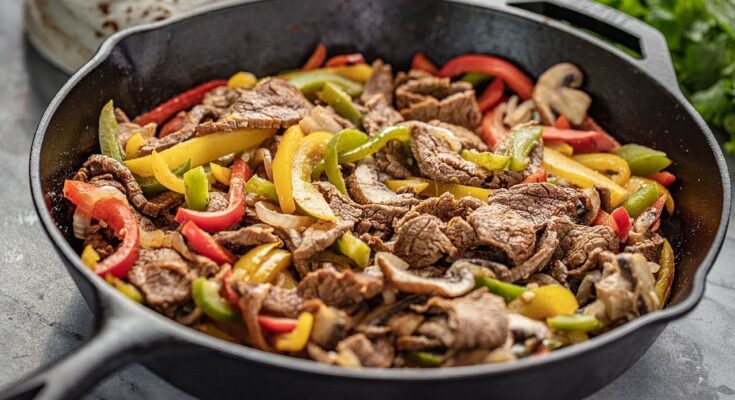Fajita Recipe: Fajitas are a sizzling, flavorful dish originating from Tex-Mex cuisine, loved for their savory, customizable combinations.
A perfect blend of spiced meat, seared vegetables, and fresh toppings, fajitas are a great option for a quick yet impressive dinner.
Whether you’re an experienced cook or a beginner, this step-by-step guide will show you how to create delicious fajitas right at home.
What You Need to Make Perfect Fajitas
Creating fajitas doesn’t require complicated ingredients, but it does benefit from some essential items to ensure the best results.
- Proteins: Traditional fajitas use beef, typically skirt or flank steak, or chicken. However, shrimp, pork, and even tofu work wonderfully too.
- Vegetables: Bell peppers and onions are classic; they add sweetness and crunch that balance the rich flavors of the meat.
- Spices: Basic spices include chili powder, cumin, garlic powder, paprika, and salt. These blend to give fajitas their signature Tex-Mex flavor.
- Tortillas: Flour tortillas are the classic choice, but corn tortillas can be a great alternative, especially for gluten-free fajitas.
Choosing the Right Meat for Fajitas
Selecting the right cut of meat is crucial for fajitas, especially if you’re using beef. For beef fajitas, skirt steak or flank steak are the best choices, as these cuts have rich flavors and tender textures. If you’re making chicken fajitas, go for boneless, skinless chicken breasts or thighs—thighs tend to be juicier and more flavorful. If you prefer shrimp, opt for medium-to-large shrimp, and be sure to remove shells and tails before cooking.
Marinating the Meat for Maximum Flavor
The marinade is the secret to mouth-watering fajitas. A good marinade helps tenderize the meat and infuse it with flavor. Here’s a simple, flavorful marinade you can use for beef or chicken:
Ingredients:
- 1/4 cup olive oil
- Juice of 2 limes
- 2 cloves garlic, minced
- 1 tsp chili powder
- 1 tsp cumin
- 1 tsp smoked paprika
- 1/2 tsp salt
- 1/4 tsp black pepper
Instructions:
- In a large bowl, whisk together all ingredients.
- Add the meat, ensuring it is fully coated in the marinade.
- Cover and refrigerate for at least 30 minutes for chicken or shrimp, or up to 8 hours for beef.
- Remove the meat from the fridge 15 minutes before cooking.
Prepping Vegetables and Other Ingredients
For fajitas, bell peppers and onions are key. Slice the bell peppers and onions into thin strips so they cook evenly. A combination of red, yellow, and green bell peppers adds color and flavor to the dish.
Other optional toppings can enhance your fajitas. These may include:
- Cheese: Cheddar or Monterey Jack works well.
- Lettuce and tomatoes for a fresh, crunchy contrast.
- Sour cream for a creamy, tangy addition.
- Salsa or guacamole to add extra flavor.
Cooking Fajitas: Techniques for Perfectly Seared Meat and Veggies
Cooking fajitas requires high heat to achieve that perfect sear on the meat and veggies.
- Heat a cast-iron skillet or grill pan over medium-high heat and add a small amount of oil.
- Cook the meat first: Add marinated meat to the pan, cooking for 5–7 minutes on each side for beef or until cooked through for chicken. Remove and let it rest before slicing.
- Sear the vegetables: In the same pan, add more oil if needed, then toss in sliced bell peppers and onions. Cook until they’re slightly charred but still crisp, about 5 minutes.
Assembling Your Fajitas
Now comes the fun part—assembling your fajitas!
- Warm the tortillas: Place them directly on a gas flame, grill, or pan for 10–15 seconds per side.
- Layer your fillings: Start with a layer of sliced meat, add the vegetables, then any additional toppings you desire.
- Fold and enjoy: Fold the tortilla around the filling, and your fajita is ready to eat!
Serving Suggestions for Fajitas
Fajitas are delicious on their own but even better with a few classic sides:
- Mexican rice: A lightly spiced side that complements fajitas.
- Refried beans: Creamy and savory, they add protein and fiber.
- Guacamole or pico de gallo: These fresh toppings can brighten up the dish.
Fajita Variations and Customizations
Traditional fajitas are always a hit, but you can switch things up depending on your tastes.
- Vegetarian: Swap meat for portobello mushrooms, zucchini, or eggplant.
- Seafood: Shrimp fajitas cook quickly and pair well with a zesty lime marinade.
- Bold flavors: Try adding chipotle or ancho chili powder for a smoky twist.
Storing and Reheating Leftovers
If you have leftovers, store them in an airtight container in the fridge for up to 3 days. To reheat, use a skillet to warm the meat and veggies for the best flavor and texture.
Common Mistakes to Avoid When Making Fajitas
- Overcrowding the pan: Cook in batches to get a proper sear on the meat.
- Overcooking veggies: Aim for a slight char without making them too soft.
- Using cold ingredients: Let meat come to room temperature before cooking for even results.
Tips for Making Fajitas Healthier
Fajitas can easily be made lighter by:
- Using whole-grain or low-carb tortillas.
- Reducing cheese or sour cream.
- Opting for leaner meats or plant-based proteins.
FAQs about Fajita Recipe
1. What are the essential ingredients for fajitas?
The essential ingredients for fajitas typically include sliced bell peppers, onions, and your choice of protein, such as chicken, beef, or shrimp. Fajita seasoning, olive oil, and tortillas complete the dish, along with optional toppings like sour cream, guacamole, and salsa.
2. How can I make fajita seasoning at home?
To make fajita seasoning, combine chili powder, paprika, cumin, garlic powder, onion powder, salt, and pepper. Add cayenne for extra heat if desired. This mix enhances the smoky, savory flavors fajitas are known for.
3. What’s the best cooking method for fajitas?
For the best flavor, cook fajitas on a high heat using a grill, skillet, or griddle. Searing the vegetables and protein quickly helps to lock in juices and develop a charred, smoky taste.
4. Can fajitas be made with other proteins?
Yes, fajitas can be made with a variety of proteins, including pork, tofu, or even mushrooms for a vegetarian option. Marinating the protein in fajita seasoning enhances flavor and tenderness.
5. How should I serve fajitas?
Serve fajitas with warm tortillas and a variety of toppings, such as shredded cheese, sour cream, salsa, and guacamole. Pair with rice or beans to make it a complete meal.
Conclusion
Making fajitas at home is not only fun but also allows you to enjoy fresh, delicious flavors customized to your taste. With a few simple ingredients and the right techniques, you can create sizzling, restaurant-quality fajitas right in your kitchen.



